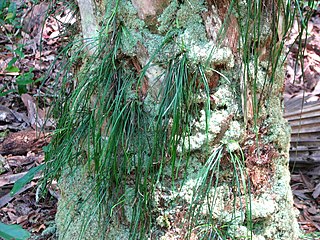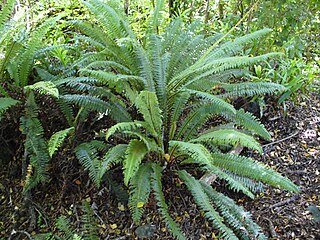
Dacrydium cupressinum, commonly known as rimu, is a large evergreen coniferous tree endemic to the forests of New Zealand. It is a member of the southern conifer group, the podocarps.

Polypodiaceae is a family of ferns. In the Pteridophyte Phylogeny Group classification of 2016, the family includes around 65 genera and an estimated 1,650 species and is placed in the order Polypodiales, suborder Polypodiineae. A broader circumscription has also been used, in which the family includes other families kept separate in PPG I. Nearly all species are epiphytes, but some are terrestrial.

Microsorum is a genus of ferns in the family Polypodiaceae, subfamily Microsoroideae, according to the Pteridophyte Phylogeny Group classification of 2016 (PPG I). The species are tropical. Like most ferns, they grow from rhizomes, rather than roots. The genus name is often misspelled "Microsorium" or "Microsoreum". It includes some species that are lithophytic rheophytes.

Alsophila smithii, synonym Cyathea smithii, commonly known as the soft tree fern or kātote, is a species of tree fern from New Zealand.

Vittaria, the shoestring ferns, is a genus of ferns in the Vittarioideae subfamily of the family Pteridaceae. It had previously been placed in the family Vittariaceae, but that family is no longer recognized.

Hymenophyllum nephrophyllum, the kidney fern, is a filmy fern species native to New Zealand. It commonly grows on the forest floor of open native bush. Individual kidney-shaped fronds stand about 5–10 cm tall. In hot weather they shrivel up to conserve moisture, but open up again when the wet returns. This species has very thin fronds which are only four to six cells in thickness. In the Māori language they are also called raurenga.

Cranfillia fluviatilis, synonym Blechnum fluviatile, is a fern known in the Māori language as kiwikiwi. A herbaceous plant, C. fluviatilis is a "hard fern" of the genus Cranfillia in the family Blechnaceae. It was identified by Patrick Brownsey in 1979. Other common names are star fern, creek fern, kawakawa and kiwakiwa.

Lomaria discolor, synonym Blechnum discolor, commonly called crown fern, is a species of fern in the family Blechnaceae. This species is endemic to New Zealand. As noted by C. Michael Hogan, this species is found in a number of forest communities in diverse locations within New Zealand, and is sometimes a dominant understory component.

Zealandia pustulata is a species of fern native to eastern Australia and New Zealand. It is commonly referred to as kangaroo fern because of its mature leaves tend to resemble the shape of a kangaroo foot. It is also referred to as hound's tongue, and as kōwaowao and pāraharaha in Māori.
Hamilton Ecological District is part of the Waikato Ecological Region in New Zealand's North Island. It occupies the Hamilton basin and surrounding foothills, and has been heavily modified with less than two percent of its indigenous vegetation remaining. This location has been studied significantly including the process of restoration ecology.

Asplenium flaccidum is a species of fern in the family Aspleniaceae. The plant common name is drooping spleenwort or weeping spleenwort, and the species name flaccidum derives from the Latin root meaning drooping. An example occurrence of A. flaccidum is within a Nothofagus-Podocarp forest at Hamilton Ecological District on New Zealand's North Island in association with other fern species understory plants, crown fern, Blechnum discolor being an example.

Alseuosmia is a genus of five species of flowering plants in the family Alseuosmiaceae, growing in New Zealand's North Island. Species members are characteristically small evergreen shrubs. An example occurrence of species representative Alseuosmia macrophylla is in the habitat of the Hamilton Ecological District, where Blechnum discolor and B. filiforme are understory elements with a Nothofagus truncata and Dacrydium cupressinum overstory.

Alseuosmia macrophylla, the toropapa or karapapa, is a plant species in the family Alseuosmiaceae. This is a small evergreen shrub which is endemic to New Zealand, along with two closely related species. An example occurrence of A. macrophylla is in the North Island habitat of the Hamilton Ecological District, where Blechnum discolor and Blechnum filiforme are understory elements with Nothofagus truncata and rimu overstory. This plant is known for the pleasant scent of its flowers, and its family name translates as "perfumed grove". The small red berries of toropapa are edible and sweet tasting. As a forest understory plant, toropapa will not tolerate full sunlight or frost, and needs its roots to stay moist and cool, however so long as these conditions are met it is reasonably hardy, and is sometimes cultivated as a garden plant.
The Sabine Valley is a landform in northern South Island, New Zealand. Much of the Sabine Valley is forested with beech canopy. Example understory vegetation is the presence of Archeria traversii within certain mountain beech forests in the upper Sabine Valley of northern South Island, New Zealand.

Raukaua simplex, or haumakāroa, is a species of evergreen plant in the Araliaceae family. This species is native to New Zealand. The species occurs in certain lowland, montane and subalpine forests from the Waihou River southward to Stewart Island and the Auckland Islands. An example occurrence in Westland forests includes associates such as Cyathea smithii and Dicksonia squarrosa.

Neopanax colensoi, commonly known as mountain five finger, is a species of evergreen plant. This species is native to New Zealand. An example occurrence in central Westland podocarp/broadleaf forests includes flora associates such as Cyathea smithii and Dicksonia squarrosa, Rumohra adiantiformis, Ascarina lucida, Pseudowintera colorata and Blechnum discolor. The maximum height of this plant is 5 meters and it is the preferred food of possums.

Raukaua edgerleyi is a species of plant which is native to New Zealand. An example occurrence in Westland District podocarp/broadleaf forests includes flora associates such as Cyathea smithii, Dicksonia squarrosa and Blechnum discolor.

Rumohra adiantiformis, the leather fern or leatherleaf fern, is a species of fern in the wood fern family Dryopteridaceae. It has a wide distribution, mainly in the tropical Southern Hemisphere.

Aglaomorpha is a genus of ferns in the subfamily Drynarioideae of the family Polypodiaceae. The Pteridophyte Phylogeny Group classification of 2016 uses this genus name, while other sources use Drynaria to include Aglaomorpha. Species are commonly known as basket ferns. As circumscribed in PPG I, the genus contains around 50 species.

Dendroconche is a genus of ferns in the family Polypodiaceae, subfamily Microsoroideae, erected in 2019. As of February 2020, the genus was not accepted by some sources.

















